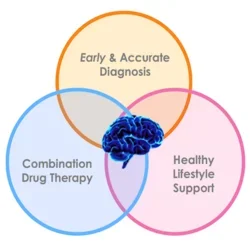Research

Overview
The Drug Discovery Lab at UCLA Neurology is working with some of the most cutting-edge technology to discover new solutions to Alzheimer's Disease. We specialize in drug synthesis using Green Chemistry™.
Our Approach

The Drug Discovery Lab approach is based on the hypothesis that Alzheimer's Disease (AD) results from imbalances in an extensive array of networks. Therefore, rather than just identifying a single new drug, we believe a more comprehensive Systems Therapeutic Approach is needed that includes both pharmacological components (single drug or multi-drug combination) and nonpharmacological components to address the various network imbalances in AD.
Our aim is to identify and develop small molecule compounds as new therapeutics for AD. Our small molecule candidates may be NCEs (New Chemical Entities) or repurposed compounds.
New Chemical Entities (NCEs)
- Compounds that have never been tested before
- One of our NCEs is currently undergoing pre-clinical trials in preparation for clinical testing
Repurposed Compounds
- Repurposed compounds are drugs already in use for other conditions.
- They are known to be safe and have well-characterized pharmacological effects
- The allow faster clinical development
- We are testing a repurposed compound in a clinical trial for Mild Cognitive Impairment (MCI), and hope to move toward a clinical trial for AD
The cornerstone of the Drug Discovery Lab (as the name would imply) is identification and development of "small molecules" as potential new therapeutics for AD. These small molecules are mostly chemical compounds that are tested to determine if they have the desired effect, if they enter the brain, and if they are safe. Many of our small molecule candidates are multifunctional and can address multiple network components, with the idea that a single molecule with a combination of biological activities may deliver a more powerful, synergistic therapeutic effect. To date, we have designed and synthesized over 100 promising "new chemical entities" (NCEs), that is, chemical compounds that have never been created previously. We rely on our extensive expertise of our chemists to design these new molecules, and our screening team to determine if a new compound is effective. NCEs must undergo complete pre-clinical and clinical testing for both safety and efficacy. One of our NCEs, under development with the support of a corporate sponsor, has even advanced to pre-clinical testing in anticipation of a clinical trial.
Many of our compounds are "repurposed." Repurposed compounds are typically approved drugs currently used for another, non-AD condition. We determine if they have anti-AD effects in our assays. The great advantage of our testing existing drugs is that they have already passed rigorous safety testing and have known pharmacological effects. This knowledge allows rapid progression to clinical trials to look for anti-AD effects (efficacy). Many "clinical compound libraries" exist containing thousands of compounds and can be screened rapidly. In fact, one of the repurposed compounds that we identified (by screening a library) is currently in a clinical trial to treat Mild Cognitive Impairment (MCI), a condition that often precedes development of full-blown AD. Because this drug is already known to be safe, if it shows clinical efficacy in improving memory and cognitive skills in MCI patients, it could rapidly move forward as a new therapy for AD.
Several other promising NCE and repurposed drug candidates in our drug discovery pipeline need support so that they too may progress towards clinic testing. This is one of the key areas where we need support in our efforts to find a treatment for this devastating disease.